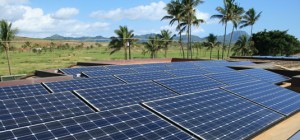 As I’ve covered before, the State of Hawaii has halted its rooftop solar incentive program (“net metering,” where solar customers get full retail electricity credit for any surplus solar they generate). Now state regulators are proposing to replace it with two options, a “grid-supply” option and a self-supply option. The outcome will be a “postcard from the future” for other states, given that Hawaii leads the country in rooftop solar penetration and high electricity prices.
As I’ve covered before, the State of Hawaii has halted its rooftop solar incentive program (“net metering,” where solar customers get full retail electricity credit for any surplus solar they generate). Now state regulators are proposing to replace it with two options, a “grid-supply” option and a self-supply option. The outcome will be a “postcard from the future” for other states, given that Hawaii leads the country in rooftop solar penetration and high electricity prices.
The grid-supply option would replace the full retail rate credit for surplus solar electricity that happens under net metering. Instead, customers would get a new tariff for surplus solar power, based on the avoided costs of fossil fuel-based generation during peak generation hours, as measured from July 2014 to June 2015. That translates to $0.151/kWh for Oahu, $0.154/kWh for Hawaii, and $0.172/kWh for Maui. That’s still a good payment for the surplus electricity, but it’s about half of what customers used to get under the full retail rate under net metering. Plus new customers will have to pay a minimum monthly bill of $25.
The self-supply option is primarily designed to support customers who do not export their surplus to the grid. Instead, they would earn retail rate credit for on-site generation that aligns with their demand. In other words, customers would strategically shift their electricity usage to soak up all their surplus solar power, such as by running all their appliances during peak daylight hours. Or they could buy a battery to store surplus solar power for dark times. Utilities would then be required to streamline interconnection for these systems.
The environmental and solar communities basically hate what state regulators are doing, as Utility Dive reports. But these proposals in fact may not dramatically stall the rooftop solar market. For example, my favorite utility, Kauai Island Utility Cooperative (KIUC), ended net metering in 2009 and replaced it with the similar grid-supply option, and their installations continued to climb. Plus, the self-supply option could serve to encourage ‘grid defection,’ as customers with batteries and solar realize they don’t actually need their utility anymore.
Certainly I’d prefer to see a more gradual transition away from net metering, as opposed to the sudden halt that happened in Hawaii. But in the long run, with continuing price declines on solar and batteries, we need to move in this new direction anyway. However, regulators shouldn’t pull the plug too quickly on the current incentives, or they may end up destroying the only bridge to this future. And that’s not a postcard I want to see, no matter how many palm trees are on it.
3 thoughts on “Hawaii’s “Postcard From The Future” On How To Pay For Rooftop Solar”
-
Pingback: Hawaii Grapples With Getting To 100% Renewables | Ethan Elkind
-
Pingback: Hawaii Has Too Much Renewable Power And Not Enough Storage | Ethan Elkind
-
Pingback: Tiny Homes In Hawaii Could Be A Large-Scale Solution For The Mainland | Ethan Elkind
Leave a Reply
You must be logged in to post a comment.


